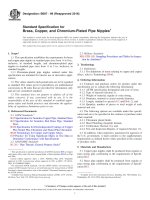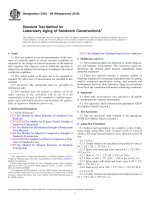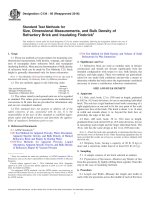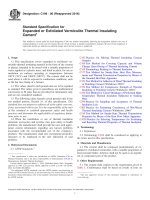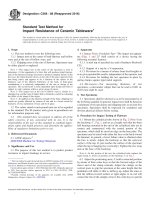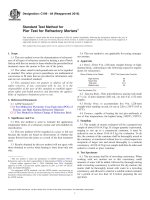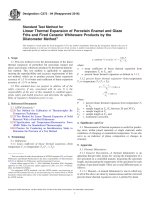Astm c 481 99 (2016)
Bạn đang xem bản rút gọn của tài liệu. Xem và tải ngay bản đầy đủ của tài liệu tại đây (72.06 KB, 2 trang )
Designation: C481 − 99 (Reapproved 2016)
Standard Test Method for
Laboratory Aging of Sandwich Constructions1
This standard is issued under the fixed designation C481; the number immediately following the designation indicates the year of
original adoption or, in the case of revision, the year of last revision. A number in parentheses indicates the year of last reapproval. A
superscript epsilon (´) indicates an editorial change since the last revision or reapproval.
This standard has been approved for use by agencies of the U.S. Department of Defense.
D1781 Test Method for Climbing Drum Peel for Adhesives
1. Scope
1.1 This test method covers the determination of the resistance of sandwich panels to severe exposure conditions as
measured by the change in selected properties of the material
after exposure. The exposure cycle to which the specimen is
subjected is an arbitrary test having no correlation with natural
weathering conditions.
3. Significance and Use
3.1 Most sandwich panels are subjected to various temperature and humidity environments. This laboratory aging test
determines the selected panel property degradation under
simulated conditions.
3.2 These test methods provide a standard method of
obtaining simulated environmental degradation data for quality
control, acceptance specification testing, and research and
development; however, these laboratory aging test procedures
do not have any correlation with natural weathering conditions.
1.2 The values stated in SI units are to be regarded as
standard. No other units of measurement are included in this
standard.
1.2.1 Exception—The inch-pound units are provided for
information only.
1.3 This standard does not purport to address all of the
safety concerns, if any, associated with its use. It is the
responsibility of the user of this standard to establish appropriate safety and health practices and determine the applicability of regulatory limitations prior to use.
4. Apparatus
4.1 Water tank, steam sprayer, oven, and freezer, all capable
of maintaining the required environment.
4.2 Test apparatus, shall conform to the appropriate ASTM
Test Method listed in Section 2.
2. Referenced Documents
5. Test Specimens
2.1 ASTM Standards:2
C273 Test Method for Shear Properties of Sandwich Core
Materials
C297/C297M Test Method for Flatwise Tensile Strength of
Sandwich Constructions
C363 Test Method for Delamination Strength of Honeycomb
Core Materials
C364 Test Method for Edgewise Compressive Strength of
Sandwich Constructions
C365/C365M Test Method for Flatwise Compressive Properties of Sandwich Cores
C393 Test Method for Flexural Properties of Sandwich
Constructions
5.1 The test specimens shall conform to the appropriate
ASTM Test Method listed in Section 2.
6. Aging Test Procedures
6.1 Subject each specimen to six complete cycles of laboratory aging, using either Cycle A (more severe) or Cycle B
(milder). The time interval between cycles shall not exceed 30
min.
6.2 Cycle A:
6.2.1 Totally immerse the specimen horizontally in water at
50 6 2°C (120 6 3°F) for 1 h.
6.2.2 Spray with steam and water vapor at 95 6 3°C (200 6
5°F) for 3 h.
6.2.3 Store at −12 6 3°C (10 6 5°F) for 20 h.
6.2.4 Heat at 100 6 2°C (210 6 3°F) in dry air for 3 h.
6.2.5 Spray again with steam and water vapor at 95 6 3°C
(200 6 5°F) for 3 h.
6.2.6 Heat in dry air at 100 6 2°C (210 6 3°F) for 18 h.
1
This specification is under the jurisdiction of ASTM Committee D30 on
Composite Materials and is the direct responsibility of Subcommittee D30.09 on
Sandwich Construction.
Current edition approved Sept. 15, 2016. Published October 2016. Originally
approved in 1961. Last previous edition approved in 2011 as C481 – 99 (2011).
DOI: 10.1520/C0481-99R16.
2
For referenced ASTM standards, visit the ASTM website, www.astm.org, or
contact ASTM Customer Service at For Annual Book of ASTM
Standards volume information, refer to the standard’s Document Summary page on
the ASTM website.
6.3 Cycle B:
6.3.1 Totally immerse the specimen horizontally in water at
50 6 3°C (120 6 5°F) for 1 h.
Copyright © ASTM International, 100 Barr Harbor Drive, PO Box C700, West Conshohocken, PA 19428-2959. United States
1
C481 − 99 (2016)
6.3.2 Heat in dry air at 70 6 3°C (160 6 5°F) for 3 h.
6.3.3 Spray with hot water at 70 6 3°C (160 6 5°F) for 3
8. Calculations
8.1 After the tests following the laboratory aging treatment
are completed, calculate the results as specified in the appropriate method and compare them with the corresponding values
obtained from the tests made on material as received.
h.
6.3.4 Heat in dry air at 70 6 3°C (160 6 5°F) for 18 h.
6.4 Test Conditions:
6.4.1 Steam shall be diffused so as to contact both faces and
all edges of panel.
6.4.2 The maximum relative humidity of the air shall be
10 %; air shall be circulated by means of a fan to heat all
surfaces uniformly.
6.4.3 Water shall be sprayed so as to contact all panel
surfaces.
8.2 Calculate the degradation percentages from Eq 1.
Degradation Percentage 5
9.1 The report shall include the following:
9.1.1 Description of the test specimens as required by the
test method used,
9.1.2 Dimensions of the test specimens, core orientation,
9.1.3 Number of specimens tested,
9.1.4 The cycle (A or B) the specimens were subjected,
9.1.5 The “as received” test results,
9.1.6 The “conditioned” test results, and
9.1.7 The specimen degradation percentage; individual values and average.
7. Procedure
7.1 Make frequent inspections of the material during the
aging cycles for any signs of delamination or other disintegration. If there is any apparent damage to the material, describe
it in the report as well as the stage of the cycle in which the
damage became apparent.
7.2 Test specimens of the material is received and after
aging, in accordance with procedures selected from the following:
Delamination Strength
Tension Test
Flatwise Flexure Test
Climbing Drum Peel
(1)
9. Report
6.5 After completion of the six cycles of exposure, further
condition the specimen at a temperature of 23 6 3°C (73 6
5°F) and a relative humidity of 50 6 5 % and bring it back to
constant weight (61 %) before testing. Report the time required to attain constant weight.
Shear Test
Compressive Strength
conditioned test value
3 100
as received test value
10. Precision and Bias
10.1 Precision—It is not possible to specify the precision of
the procedure in Test Method C481 for conducting sandwich
construction laboratory aging because of the unavailability of
consistent samples for testing.
10.2 Bias—Since there is no accepted reference material
suitable for determining the bias for the procedures in this test
method, bias has not been determined.
Test Method C273
Test Methods C364 and C365/
C365M
Test Method C363
Test Method C297/C297M
Test Method C393
Test Method D1781
11. Keywords
11.1 aging; degradation; sandwich; sandwich construction
ASTM International takes no position respecting the validity of any patent rights asserted in connection with any item mentioned
in this standard. Users of this standard are expressly advised that determination of the validity of any such patent rights, and the risk
of infringement of such rights, are entirely their own responsibility.
This standard is subject to revision at any time by the responsible technical committee and must be reviewed every five years and
if not revised, either reapproved or withdrawn. Your comments are invited either for revision of this standard or for additional standards
and should be addressed to ASTM International Headquarters. Your comments will receive careful consideration at a meeting of the
responsible technical committee, which you may attend. If you feel that your comments have not received a fair hearing you should
make your views known to the ASTM Committee on Standards, at the address shown below.
This standard is copyrighted by ASTM International, 100 Barr Harbor Drive, PO Box C700, West Conshohocken, PA 19428-2959,
United States. Individual reprints (single or multiple copies) of this standard may be obtained by contacting ASTM at the above
address or at 610-832-9585 (phone), 610-832-9555 (fax), or (e-mail); or through the ASTM website
(www.astm.org). Permission rights to photocopy the standard may also be secured from the Copyright Clearance Center, 222
Rosewood Drive, Danvers, MA 01923, Tel: (978) 646-2600; />
2
